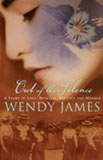 | Wendy James OUT OF THE SILENCE Random House, 351 pp. Review by Perry Middlemiss |
Out of the Silence by Wendy James was released in October 2005 by Random House, and was, reportedly, the only Australian debut novel published by the company that year. As it happens they chose well - it's a good one.
The novel in set in Melbourne and country Victoria during the period of the late 1890s and early 1900s, a time of stifling social and political conservatism, sexual double-standards and rampant hypocrisy. Yet it was also a time when the women's suffrage movement was starting to organise and spread its message, a time when women were pushing back against the barriers imposed by men. It is against this background that the author has pitched the stories of Maggie Heffernan, Elizabeth Hamilton and Vida Goldstein, each of whom with ambitions beyond their perceived social standing.
Maggie Heffernan is a lively country working-class young woman whose life is the main thrust of the book. She becomes engaged to a local rake, but finds herself abandoned after she falls pregnant. The novel follows her grim journey from the country to the city, vainly seeking her ex-fiance, finding herself destitute and finally accused of a dreadful crime. Vida Goldstein is an educated single woman running a local private school, campaigning for votes for women and contemplating running for parliament. Elizabeth Hamilton lives in Vida's aunt's house in suburban Melbourne - an upper middle-class life that provides a sharp contrast with poor Maggie's circumstances. Elizabeth and Vida take up Maggie's cause after her arrest and while their efforts don't meet with total success, all characters are changed by the events within the book.
Elizabeth's story is told in a series of letters to her brother Robert, who lives in America, and in extracts from her journals. These alternate with Maggie's first-person narration of her own account. The easiest approach to this story would be to start at the beginning and to follow tight on Maggie's life-line, extracting every skerrick of pathos and anguish along the way, squeezing it dry of all emotion. But that's too simplistic a method to tell this tale properly and James rightly has taken the harder road and has achieved a better final product as a result.
There is an art to getting this narrative approach just right. Make the sections too short and the narrative loses its forward momentum, make them too long and the reader loses the thread of what is happening in the other plot-line and gets frustrated. This is a delicate balancing act that James maintains with some skill, adding newspaper clippings and even cutting Elizabeth's journal entries; to provide extracts of extracts, if you like. The effect is to increase the amount of white space on the page, reducing the heavy blocks of text so often found in "Victorian" novels, and thereby easing the reading experience in sections where setting and background information is provided. This exhibits a remarkable technique for a debut novel.
Beyond the writing technique we have a writer who is knowledgeable about the era in which the novel is set, yet who presents that research lightly. A lot of care appears to have been taken to present the right amount of background and scene-setting information without swamping the reader with too much detail. And yet a close-reading of the text will inform as well as entertain.
In the Author's Note, it is stated that the characters of Maggie Heffernan and Vida Goldstein are based on historical figures, while Elizabeth Hamilton is purely fictional. To this reader, the introduction of the character of Elizabeth is the component that allows the novel to reach its heights. The slow revealing of her own unfortunate history, including the miscarriage of the child she had conceived with a deceased lover, highlights the social injustices and hypocrisy suffered by Maggie. She also provides the link between Vida and Maggie, bridging the social and intellectual gaps between the characters. Without her the novel would have been a very different book indeed.
This is an accomplished work from a writer with the feel for the flow of a story, the capacity to see how to assemble disparate parts of a novel, and the ability to inhabit her characters fully. I look forward to her next work.
